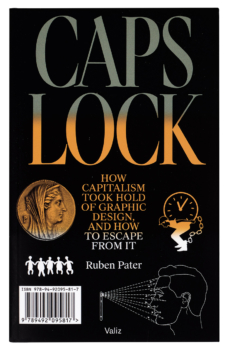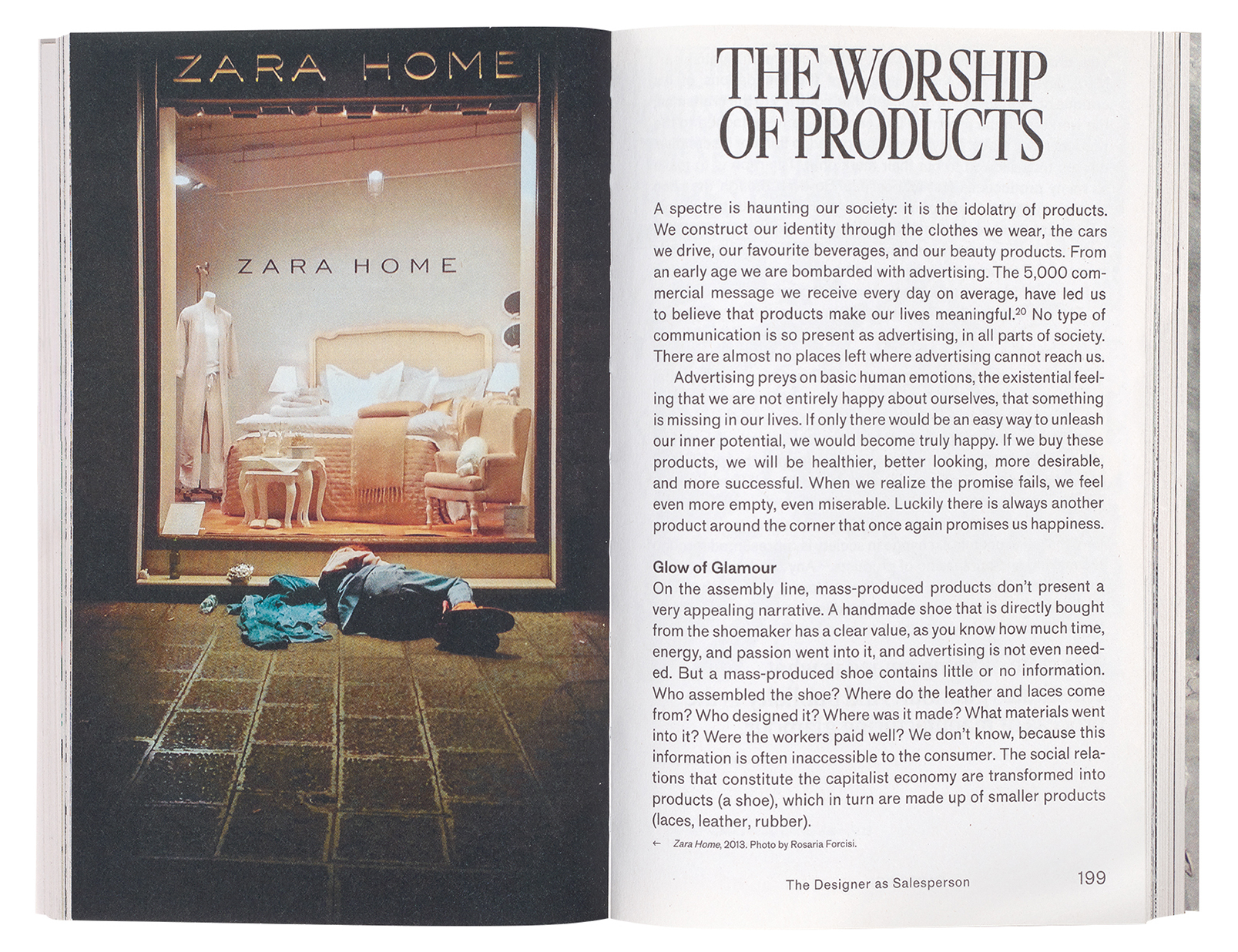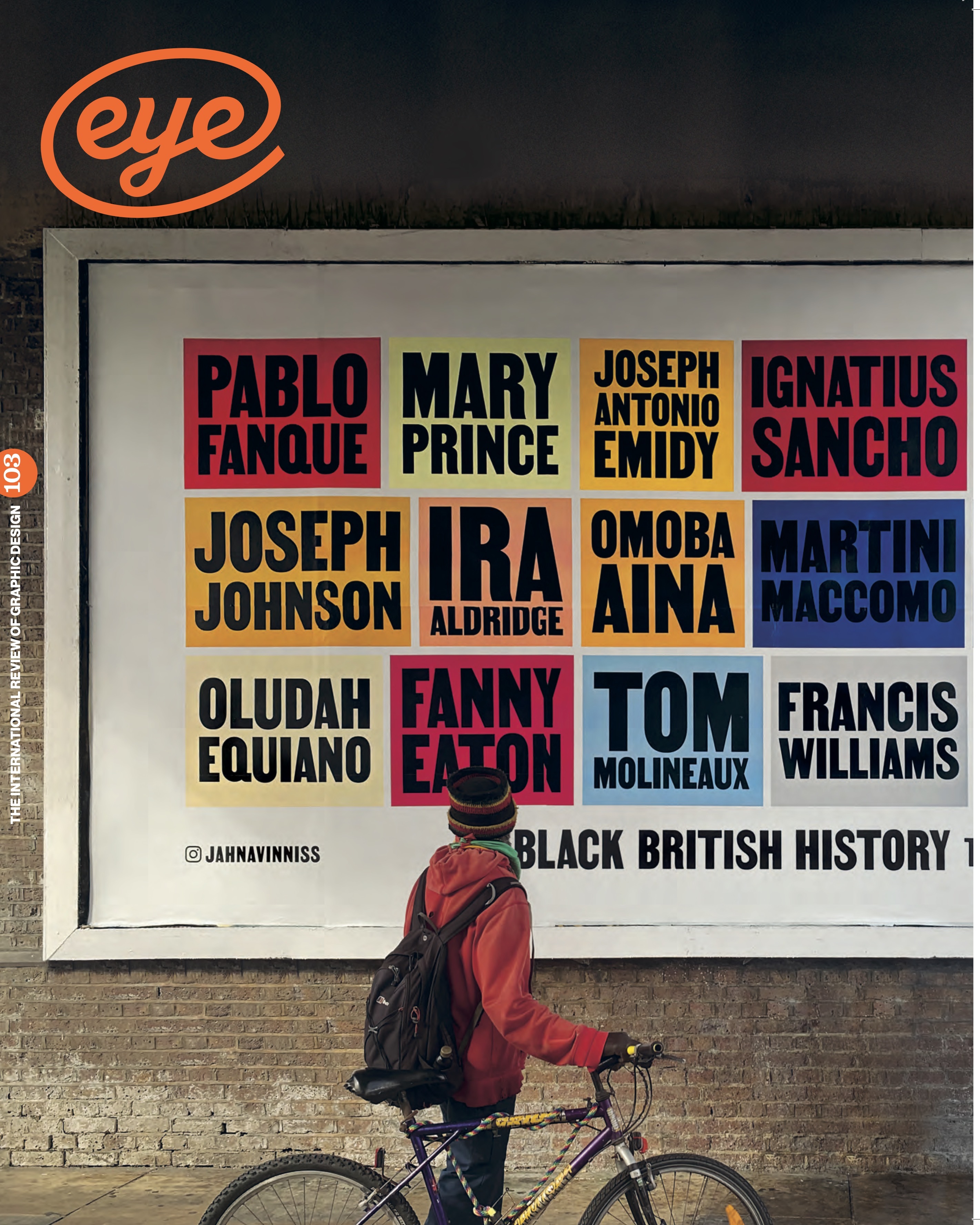Summer 2022
Fighting words
CAPS LOCK: How capitalism took hold of graphic design, and how to escape from it
Text and design by Ruben Pater, Valiz, £22.50 (paperback)
There is an elephant in the room, but there are some signs that we are beginning to notice its footprints on the rug. Finally, after 56 years of dancing around the subject, in the 2020 revision of the First Things First manifesto, members of the graphic design community plucked up the courage to use the word ‘capitalism’ in connection with the suggestion that everything might not be quite right in the industry. In CAPS LOCK: How capitalism took hold of graphic design, and how to escape from it, Ruben Pater pulls no punches, presenting a brutally honest examination of graphic design’s systemic and deep-rooted historical and present-day complicity in the unjust, exploitative and oppressive political, economic and social systems of local and global capitalism.
The foundational narrative of CAPS LOCK is that graphic design is not an originally innocent pure spirit later corrupted and coerced into the service of capitalism. Rather, graphic design emerged and developed symbiotically with capitalist economic systems, and is therefore not just a bystander, but an active accomplice implicated in all of the problematic complexity of capitalism’s effects in our lives. In presenting this case and its implications the book is certainly ambitious in its scope. Running to over 500 pages the reader is taken on a whirlwind tour of how graphic design came to be so deeply and inextricably embedded within capitalist systems and what the resulting effects of this are.
Part one of the book presents a historical
(materialist) narrative setting out the integral role which graphic design
activity has played, and continues to play, in the creation and sustaining of
capitalist systems. We see how capitalism could never have made it past the
starting gate without the facilitation of those scribes able to typographically
document financial transactions: from ancient Mesopotamian records of debt
inscribed on miniature clay tablets, to the design of coins, paper money, stock
markets and credit cards. We see how the design of graphic systems created to
solve administrative ‘problems’ of standardised measurement are an integral
feature of the capitalist compulsion to count, quantify and ultimately own
data, goods, land and labour. The enabling fingerprints of graphic design are
discovered all over a trail connecting European merchant colonialism and
slavery to present day corporate identity branding, marketing and advertising
practices, tax avoidance, gentrification, CIA torture sites and military coups.
Cover of CAPS LOCK: How capitalism took hold of graphic design, and how to escape from it designed by Ruben Pater. Top. Spread from CAPS LOCK juxtaposing Tesla’s Elon Musk with a Bolivian miner.

Part two of the book explores the active roles that graphic designers themselves play in maintaining exploitative and oppressive working conditions, precarity, unpaid labour, unhealthy competition and unrealistic expectations endemic throughout the industry today. Possibilities for resistance, refusal and alternative practices shine through the cracks in glimpses of the potentials of solidarity, unionisation, creative commons and alternative education models. Part three of CAPS LOCK more fully draws out these themes, discussing four possible alternative approaches towards less / anti- /non-capitalist graphic design activity. Chapters on the designer as hacker, futurist, philanthropist and activist explore the potentials and pitfalls of such attempts to ‘escape’, reflecting on capitalism’s ability to appropriate and assimilate even the most earnest attempts at dissent and divergence.
The most optimistic pathways to potential ‘escape’ are found in the final section on activist approaches, which presents examples of six groups attempting to work in graphic design today in non-capitalist ways, whether through the nature of their work, their working processes, or their organisational structures.
In these case studies we see groups of designers deeply embedded within their own communities, operating on principles of care rather than competition, co-creation and reciprocal mutual aid rather than pro bono charity. We see designers resisting hierarchy, exploitation and precarity: organised as social enterprises, collectives and cooperatives. We see designers using their own currencies, writing their own software, refusing the enclosure of intellectual property by using Copyleft and creative commons. We see living spaces being shared and salaries being collectively agreed based on need rather than seniority. We see work and life blending not in exploitative but in positive, healthy ways, as activities like child-care, bicycle maintenance, and study are valued and considered as integral components of work. These are not typical aspirational images of the imaginary lifestyles of superstar designers, but modest glimpses of a more humane discipline. The challenges, trade-offs and compromises made by each of the six groups in pursuit of fairer, more equitable and socially sustainable ways of working are well worth reflecting upon.
Spread from chapter of CAPS LOCK entitled ‘The Designer as Salesperson’, featuring ’Zara Home’ by Rosaria Forcisi, 2013.

At face value, a 552-page book on the relationship between graphic design and capitalism referencing Marx, Deleuze, Bourdieu, Foucault etc. sounds like a hard sell in 2022. However despite its length, CAPS LOCK is an easy and enjoyable read (if you can forgive some of Pater’s idiosyncratic grammatical quirks). Pater does not shy away from key theoretical and philosophical ideas, but also never gets bogged down in these, keeping the pace lively, with vibrant examples and illustrations close to hand at all times. Perhaps the most remarkable achievement of the book is that it is (almost) never preachy. Pater walks a careful line. Though unapologetically radical, the narrative presented is measured and reasonable throughout, accessible but with enough depth to have bite and encourage further investigation.
No single volume could encompass a full account of graphic design’s complex and problematic relationship with capitalism. Pater describes CAPS LOCK as only a ‘preliminary analysis’ of some of the key issues at stake here for practising designers, and an attempt to approach the subject with more nuance than conventional ‘good client’ vs ‘bad client’ narratives. With this number of pages in small paperback format, the book has a distinctly chunky feel in the hand, mirroring the heft of the message within. It feels fitting that the book arrives with both the form and force of a brick through a window. I can’t think of many graphic design windows that wouldn’t benefit from the breath of fresh air that CAPS LOCK delivers.
Peter Buwert design ethics researcher, educator, Edinburgh
First published in Eye no. 103 vol. 26, 2022
Eye is the world’s most beautiful and collectable graphic design journal, published for professional designers, students and anyone interested in critical, informed writing about graphic design and visual culture. It is available from all good design bookshops and online at the Eye shop, where you can buy subscriptions and single issues.

